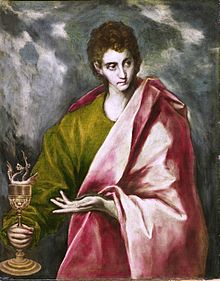Sehet, welch eine Liebe hat uns der Vater erzeiget, BWV 64 Sehet, welch eine Liebe hat uns der Vater erzeiget Occasion Third Day of Christmas Bible text 1 John 3:1 Chorale Performed 27 December 1723 (1723-12-27 ) : Leipzig Movements 8 Vocal Instrumental cornett 3 trombones oboe d'amore 2 violins viola continuo
Sehet, welch eine Liebe hat uns der Vater erzeiget [ 1] BWV 64church cantata by Johann Sebastian Bach . He composed the Christmas cantata in Leipzig in 1723 for the third day of Christmas , which is also the Feast of John the Evangelist , and first performed it on 27 December 1723.
History and text
Bach wrote the cantata in his first year as Thomaskantor in Leipzig , as part of his first cantata cycle , for the Third Day of Christmas .[ 2] Epistle to the Hebrews , Christ is higher than the angels, (Hebrews 1:1–14 ) and the prologue of the Gospel of John , also called Hymn to the Word (John 1:1–14 ). The unknown poet referred only in a general way to the readings and stressed the aspect that being loved by God in the way which Christmas shows, the believer does not have to be concerned about the "world" any more. Three chorales are included in the text, rarely found in Bach's cantatas, but also in Darzu ist erschienen der Sohn Gottes , BWV 40Schau, lieber Gott, wie meine Feind , BWV 153movement is based on 1 John 3:1 . The only Christmas chorale is verse 7 of Luther's "Gelobet seist du, Jesu Christ [ 3] [ 4] Balthasar Kindermann 's "Was frag ich nach der Welt [ 5] [ 6] Gute Nacht, o Wesen Johann Franck 's "Jesu, meine Freude [ 7] [ 8] [ 2]
Scoring and structure
The cantata is scored for soprano , alto and bass soloists, a four-part choir , zink and three trombones , oboe d'amore , two violins , viola , and basso continuo .[ 9]
Chorus: Sehet, welch eine Liebe hat uns der Vater erzeiget
Chorale: Das hat er alles uns getan
Recitative (alto): Geh, Welt! behalte nur das Deine
Chorale: Was frag ich nach der Welt
Aria (soprano): Was die Welt in sich hält
Recitative (bass): Der Himmel bleibet mir gewiß
Aria (alto): Von der Welt verlang ich nichts
Chorale: Gute Nacht, o Wesen
Music
The opening chorus is set in motet style; an archaic-sounding choir of trombones doubles the voices.[ 2] recitative is accompanied by vigorous scales in the continuo. In the soprano aria, a Gavotte , a virtuoso solo violin possibly represents the "worldly things". The alto aria is accompanied by the oboe d'amore in melodic lyricism. The chorale "Gute Nacht, o Wesen [ 1] [ 2]
Recordings
Bach Cantatas Vol. 1 – Advent and Christmas , Karl Richter , Münchener Bach-Chor , Münchener Bach-Orchester , Edith Mathis , Anna Reynolds , Dietrich Fischer-Dieskau , Archiv Produktion 1972Die Bach Kantate Vol. 63 , Helmuth Rilling , Gächinger Kantorei , Bach-Collegium Stuttgart , Arleen Augér , Ann Murray , Philippe Huttenlocher , Hänssler 1981J. S. Bach: Complete Cantatas Vol. 8 , Ton Koopman , Amsterdam Baroque Orchestra & Choir , Dorothea Röschmann , Bogna Bartosz , Klaus Mertens , Antoine Marchand 1998J. S. Bach: Cantatas Vol. 13 , Masaaki Suzuki , Bach Collegium Japan , Yukari Nonoshita , Robin Blaze , Peter Kooy , BIS 1999Bach Cantatas Vol. 15: New York , John Eliot Gardiner , Monteverdi Choir , English Baroque Soloists , Gillian Keith , Robin Tyson , Peter Harvey , Soli Deo Gloria 2000
References
^ a b Dellal, Pamela (2021). "BWV 64 – Sehet, welch eine Liebe hat uns der Vater erzeiget" . pameladellal.com . Retrieved 23 December 2021 .^ a b c d Gardiner, John Eliot (2006). Johann Sebastian Bach (1685-1750) / Cantatas Nos 57, 64, 133 & 151 Soli Deo Gloria (at Hyperion Records website). Retrieved 31 December 2018 .^ "Gelobet seist du, Jesu Christ / Text and Translation of Chorale" . Bach Cantatas Website. 2003. Retrieved 11 December 2012 .^ "Chorale Melodies used in Bach's Vocal Works / Gelobet seist du, Jesu Christ" . Bach Cantatas Website. 2010. Retrieved 11 December 2012 .^ "Was frag ich nach der Welt / Text and Translation of Chorale" . Bach Cantatas Website. 2006. Retrieved 11 December 2012 .^ "Chorale Melodies used in Bach's Vocal Works / O Gott, du frommer Gott" . Bach Cantatas Website. 2005. Retrieved 11 December 2012 .^ "Jesu, meine Freude / Text and Translation of Chorale" . Bach Cantatas Website. 2006. Retrieved 11 December 2012 .^ "Chorale Melodies used in Bach's Vocal Works / Jesu, meine Freude" . Bach Cantatas Website. 2006. Retrieved 11 December 2012 .^ Dürr, Alfred (1981). Die Kantaten von Johann Sebastian Bach 130–132 . ISBN 3-423-04080-7
Sources
Sehet, welch eine Liebe, BWV 64 (Bach, Johann Sebastian) : Scores at the International Music Score Library Project Sehet, welch eine Liebe hat uns der Vater erzeiget BWV 64; BC A 15 / Sacred cantata (3rd Christmas Day) Bach Digital Cantata BWV 64 Sehet, welch eine Liebe hat uns der Vater erzeiget : history, scoring, sources for text and music, translations to various languages, discography, discussion, Bach Cantatas WebsiteBWV 64 Sehet, welch eine Liebe hat uns der Vater erzeiget : English translation, University of Vermont BWV 64 Sehet, welch eine Liebe hat uns der Vater erzeiget : text, scoring, University of Alberta Chapter 32 BWV 64 Sehet, welch eine Liebe hat uns der Vater erzeiget / See what love the Father has shown us. : a listener and student guide by Julian Mincham, 2010Luke Dahn: BWV 64.2 , BWV 64.4 , BWV 64.8 bach-chorales.com
International National Other
